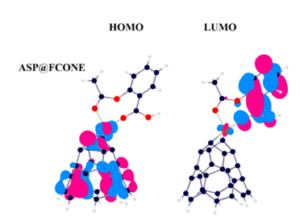In this study, removal of Acid blue 62 from aqueous solution by mesoporous silicate MCM-41 modified by Aminopropyltriethoxysilane (APTES) composite was studied. Properties of synthesized composite were analyzed and confirmed by SEM, EDX and FTIR. Results show that Langmuir adsorption isotherm has the best compatibility with the results of experiments. Kinetic analysis using pseudo-first-order model, […]
We have performed density functional theory investigations on the adsorption properties of ammonia molecule on the undoped and N-doped TiO2 anatase nanoparticles. We have geometrically optimized the constructed undoped and N-doped nanoparticles in order to fully understand the adsorption behaviors of ammonia molecule. For TiO2 anatase nanoparticles, the binding site is preferentially located on the […]
In this work, adsorption kinetics were investigated in order to remove the acid blue 62 off the aqueous solutions using mesoporous silicate SBA-15 loaded with tannic acid (tannin-SBA-15). Nitrogen adsorption and desorption test (BET), X-ray diffraction (XRD) and Fourier transform infra-red spectroscopy (FT-IR) analysis characterize synthesized composite. The impacts of some parameters such as PH, […]
In this paper, Taguchi method was applied to determine the optimum conditions for Zn (II) removal from aqueous solution by halloysite nanotubes (HNTs). An orthogonal array experimental design (L16 (45) which is of five control factors including pH, t (contact time), m (adsorbent mass), T (temperature) and C0 (initial concentration of Zn (II)) having four […]
The role of enzyme engineering in biotechnology, biological and pharmaceutical process cannot be over emphasized. This study compared the adsorption of amylase and protease on to manganese ferrite (MnFe2O4). The metal ferrite was synthesized via a sol – gel technique and characterized with scanning electron microscopy (SEM), X-ray diffraction (XRD), Electron paramagnetic resonance (EPR) and Fourier […]
In-situ polymerization method was adapted to prepare a novel tin cerium phosphate-polyaniline nano composite ion exchange material. The physico-chemical properties of the material were determined using Fourier Transform Infra-Red (FTIR) Spectroscopy, Scanning Electron Microscopy (SEM), Thermogravimetric Analysis (TGA), and X-ray diffraction (XRD). X-ray diffraction study showed that the composite material formed is highly crystalline in […]
By the importance of customizing appropriate carriers for the specific drugs to approach a successful drug delivery process, the drug delivery of aspirin (ASP) was assessed by the assistance of an iron-enhanced nanocone (FCONE), using density functional theory (DFT) calculations. ASP, CONE, and FCONE models were optimized to be prepared for involving in bimolecular interactions […]
